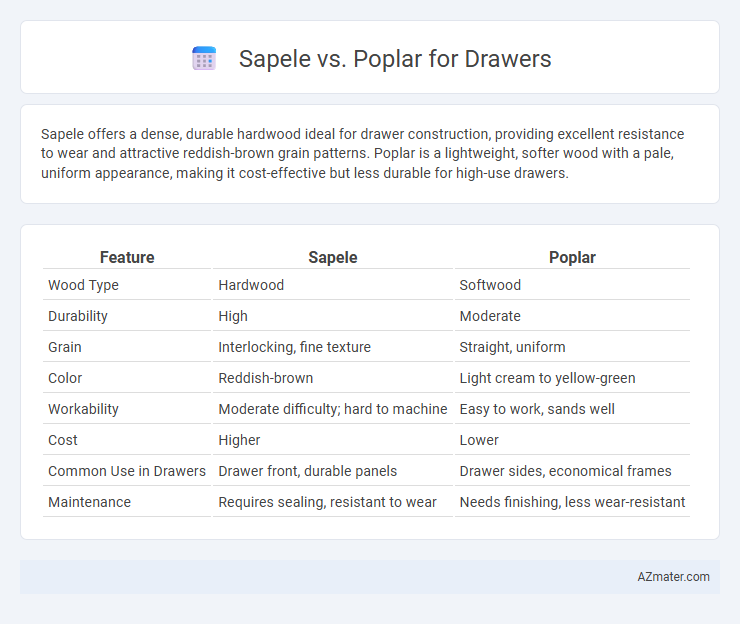Sapele offers a dense, durable hardwood ideal for drawer construction, providing excellent resistance to wear and attractive reddish-brown grain patterns. Poplar is a lightweight, softer wood with a pale, uniform appearance, making it cost-effective but less durable for high-use drawers.
Table of Comparison
| Feature | Sapele | Poplar |
|---|---|---|
| Wood Type | Hardwood | Softwood |
| Durability | High | Moderate |
| Grain | Interlocking, fine texture | Straight, uniform |
| Color | Reddish-brown | Light cream to yellow-green |
| Workability | Moderate difficulty; hard to machine | Easy to work, sands well |
| Cost | Higher | Lower |
| Common Use in Drawers | Drawer front, durable panels | Drawer sides, economical frames |
| Maintenance | Requires sealing, resistant to wear | Needs finishing, less wear-resistant |
Introduction: Sapele vs Poplar for Drawer Construction
Sapele and Poplar are popular choices for drawer construction due to their unique properties and performance. Sapele, a hardwood from the mahogany family, offers superior durability, rich reddish-brown color, and fine grain patterns, making it ideal for drawers requiring strength and aesthetic appeal. Poplar, a softer hardwood with a lighter color and straight grain, provides ease of machining and cost-effectiveness, suitable for budget-friendly or painted drawer projects.
Wood Characteristics: Sapele and Poplar Overview
Sapele wood is a dense, durable hardwood with a fine, interlocking grain that offers rich reddish-brown hues and a natural luster, making it ideal for high-quality drawers requiring strength and an attractive finish. Poplar, on the other hand, is a lightweight, softer hardwood with a straight grain and pale yellow to greenish tones, prized for ease of machining and affordability but less suited for heavy-duty applications due to lower hardness and durability. When choosing between Sapele and Poplar for drawers, consider Sapele's superior hardness (approximately 1,410 on the Janka scale) and stability versus Poplar's moderate hardness (~540 Janka) and cost-effectiveness for projects prioritizing budget over longevity.
Durability and Strength Comparison
Sapele wood offers superior durability and strength compared to Poplar, making it ideal for drawer construction where longevity is crucial. With a Janka hardness rating of 1,410, Sapele resists dents and scratches better than Poplar, which has a softer Janka rating around 540. This strength results in more robust drawer frameworks that can withstand frequent use without warping or damage over time.
Workability and Ease of Machining
Sapele offers moderate workability, with interlocked grain that can cause some difficulty in planing and sanding, making it less smooth to machine compared to poplar. Poplar is highly regarded for its excellent workability and ease of machining, allowing for clean cuts, smooth surfaces, and minimal tool wear. For drawer construction, poplar is preferred when optimal machine efficiency and fine finishing are priorities, while sapele provides greater durability but requires more careful handling.
Appearance and Aesthetic Appeal
Sapele features a rich reddish-brown color with a distinctive interlocking grain pattern, offering a luxurious and warm aesthetic ideal for high-end drawer fronts. Poplar, on the other hand, has a lighter, creamy white to yellowish hue with a relatively straight and uniform grain, making it a versatile and cost-effective option that takes paint and stains well. The choice between Sapele and Poplar for drawers largely depends on whether a natural hardwood look or a customizable finish is preferred for the overall furniture design.
Cost and Availability
Sapele wood is generally more expensive than poplar due to its rich reddish-brown color and durability, making it a premium choice for drawer construction. Poplar is widely available and budget-friendly, often chosen for its affordability and ease of workability despite its softer texture. Availability of sapele can be limited depending on the region, whereas poplar is commonly found in North America, ensuring consistent supply for drawer manufacturing.
Finishing and Staining Properties
Sapele exhibits a fine, uniform grain that takes stain evenly, producing a rich, reddish-brown finish ideal for elegant drawer surfaces. Poplar's softer texture accepts paint and stains well but often requires a pre-conditioner to ensure an even, smooth finish without blotching. Both woods offer versatility in finishing, but Sapele delivers superior depth and warmth in staining, enhancing the drawer's visual appeal.
Environmental Impact and Sustainability
Sapele wood, sourced primarily from West African rainforests, is often less sustainable due to deforestation concerns and slower regrowth compared to Poplar, which is widely cultivated in North America with faster growth cycles and better renewability. Poplar's environmental impact is lower, benefiting from managed plantations that reduce biodiversity loss and carbon footprint, making it more eco-friendly for drawer construction. Choosing Poplar supports sustainability goals through responsible forestry practices, whereas Sapele demands careful sourcing to mitigate ecological damage.
Best Applications: When to Use Sapele or Poplar
Sapele is ideal for drawer fronts and furniture requiring a rich, reddish-brown finish with excellent durability and resistance to wear, making it perfect for high-traffic areas or heirloom-quality pieces. Poplar is best used for painted drawers or components where cost-effectiveness and ease of machining are important, providing a smooth surface that accepts paint well without compromising structural integrity. Choose Sapele when aesthetic appeal and longevity are priorities, and Poplar when budget and paintability are key factors.
Conclusion: Which Wood is Better for Drawers?
Sapele offers superior durability and a rich, reddish-brown finish, making it ideal for drawers subject to frequent use and requiring a more luxurious appearance. Poplar is softer and lighter in color, suitable for painted drawers or budget-friendly projects where ease of workability is prioritized. For long-lasting, visually striking drawers, Sapele is generally the better choice.

Infographic: Sapele vs Poplar for Drawer
 azmater.com
azmater.com